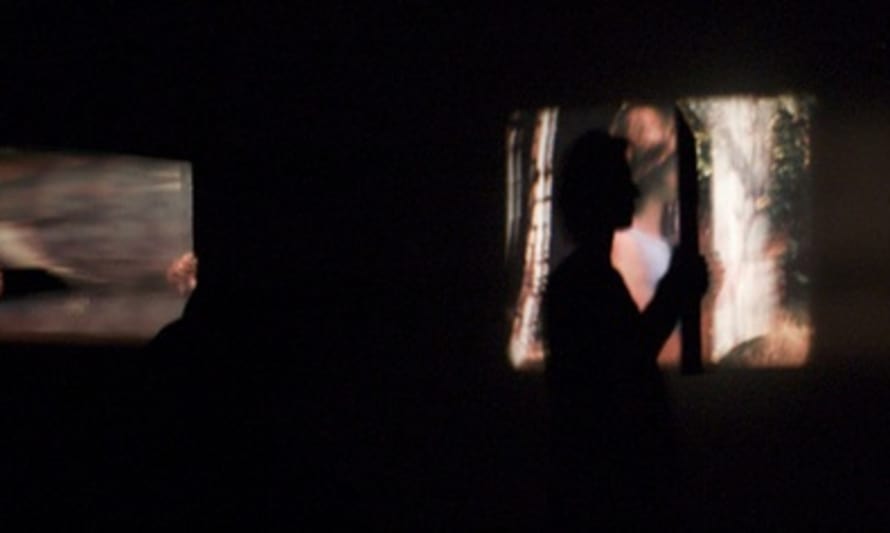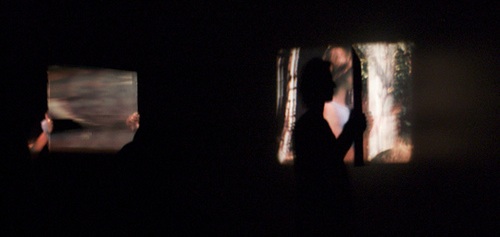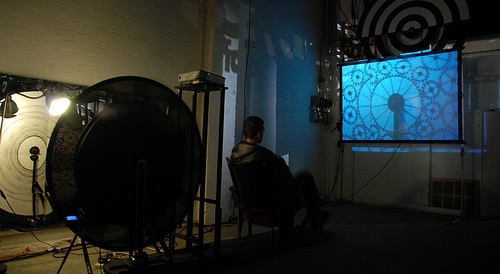
Guy Sherwin and Kevin Timmins
By complete coincidence, it turned out that one of the people showing work at this year's Flatpack (Kevin Timmins) was a student of another (Guy Sherwin). As they're also interested in similar areas we asked them if they'd mind interviewing each other. Thanks to a tornado of festival logistics we didn't get round to sharing the results, but better late than never ---
Kevin Timmins:
I believe you studied painting originally, how, when and why did you happen to become involved in film?

Guy Sherwin: A couple of factors - my paintings were getting longer and thinner - I was interested in the time dimension, and film was this new radical medium full of unrealised potential. This was in the late 60s.
Similar question for yourself. What were you doing before the Bicycle Piece, and how did you get the idea?
KT: I was making short documentary works on my grandparents with my DV camcorder in 2005; it was really a pivotal starting point. I became interested in the history of the moving image and the workings of the human eye. Pre-cinema devices just seemed to fascinate me. I love my bicycle as well so the two seemed to mesh in some mad kind of harmony.
It sounds like your paintings were turning into the celluloid strip itself. So how did you begin your investigation with this innovative new time based medium? Where there any artists or writers that inspired you at this particular point in time?
GS: Yeah there's a lot in common between bicycles and film! Trains too. A few years back I put together a programme of train films made by artists. In my research, in the cellar of the BFI, I saw some beautiful early hand-painted films of landscapes shot from a train. The train provides a ready made tracking shot.
Well, I shot a few embarrassing experiments on standard 8mm but started to take myself more seriously working in 16mm. Early on I got intrigued by the idea of 'optical sound' - the fact that you can create sound by visual means, and I tried to think through ideas of aural/visual equivalence. I made a loop of 11 image-moments against 12 sound-moments in order to see how the brain deals with this aural/visual slippage. This piece might have been influenced by Steve Reich's early sound phasing pieces, but I'm not sure. One certain influence was a film called Arnulf Rainer by the Austrian Peter Kubelka that consisted only of black or white frames and white noise or silence, composed into various rhythmic patterns. Overall my main influence was the work of the London Filmmakers Co-op, in particular the film performances of Malcolm LeGrice and Annabel Nicolson.
Working in the West Midlands I guess it’s hard to see much work made on film without travelling long distances. I'm curious as to what kinds of film (or video) work have influenced your practice? Writers too? Incidentally, the only writings that might have directly influenced my practice were by perceptual psychologists such as Rudolf Arnheim.
KT: Yeah for sure it can be real difficult to get out there and see work. Lots of 19th century inventors/scientists influenced the piece in the flatpack festival. People like Joseph Plateau and Etienne-Jules Mary. Carsten Holler has been a big inspiration also. As for film and video works and writers, I’m really enjoying the works of Chris Welsby, William Raban and Tony Oursler at the moment. I’m also reading A History of Experimental Film and Video by A.L. Rees and Principles of Visual Perception by Carolyn Bloomer.
My most powerful influence has been technology itself, things like film cameras, projectors and televisions etc... I like to pull things apart, find out how they work and really just experiment. Yesterday I striped down an old CRT hung it from a rusty swing, attached a motion sensor to the bottom and just left it. When people pushed it the sensor detected motion and it turned itself on, it did blow up by the end of the day but it was still a lot of fun.
What was it like to be involved with the LFMC at that time, any memorable moments? The book I’m reading at the moment tries to site the avant-garde; it seems like a complex set of affairs. I wondered if you could comment on what Avant-garde means to you and how you think the terms meaning has changed from the 70’s to present?
GS: It's hard to describe in brief, but the period of the early 70s at the London Film Makers Co-op did feel like a genuine avant-garde moment. That term is used nowadays often very loosely to describe things that are merely stylistically similar, but then it seemed like a rare avant-garde moment when film seemed to be the most advanced and dynamic art form that was breaking new ground (against a background of commercial galleries, Hollywood and television). Many things seemed possible and seemed that they might happen, but didn't, at least not then...
What work are you showing at Flatpack? Is it online anywhere?

KT: I’m showing my Pedal Powered Phenakistoscope, it’s based on the optical device, but the work has many other elements thrown into the mix. The device is attached to a bicycle drive which viewers can operate from an old 1930’s cinema seat. There will also be a digital camera and projector present feeding a live stream of images from disc to screen. When I try and explain this to people they frown a lot so all I can say is come down to the festival and have a go yourself, it’ll all make sense in the end I promise hahaha. I don’t have much stuff online at the moment to be honest. A website is in the pipeline but I’m not sure when it’ll be up and running.
So what are you showing at Flatpack number 3?
GS: It's an interesting mix of old and new technologies you've got there. They each seem to comment on the other. I'm looking forward to seeing it in its new location.
I'm showing 5 pieces at Flatpack, two of which are online, on Youtube that is: 'Man with Mirror' which is a live performance interaction with a film of me holding a mirror, and 'Cycles #3' which uses two 16mm projectors superimposed and a simple hand-made image of a circle, with its accompanying hand-made sound, pulsating at differing speeds. The second one is quite a trip! And the first one plays with your head in other ways... The other films that I'm showing also use live manipulation of projectors.
KT: You say you use live manipulation of projectors, how and why do you do this? What influenced you to move into the performative aspects of film?
GS: The performative aspect of film that I've got heavily involved in came initially from seeing the work of Malcolm LeGrice, Annabel Nicolson and William Raban at the LFMC in the 70s. They were all involved in various kinds of performance with film. I made several myself at that time too, and then came back to it after a gap of a couple of decades. I think I'm attracted to the idea of film being alive, fluid, unfixed, performative, maybe aspiring to the condition of music. After years of screening the 'fixed' films that I've made - seeing them over and over - they become like dead things. If I'm going to do a show I'm happier if I'm doing something rather than just watching my own films.
So, do you have any plans to develop the bicycle idea once you've left uni? What are you working on now?
KT:
The same question to you, what’s in the pipeline and what does the future hold?
GS: You're a good interviewer! Better than me. I've got a one and a half year old boy so things are on a slow burn in other creative respects, but I'm working on publishing a couple of dvds of earlier films, and when I get shows, like at Flatpack, I use them to try out the performances in different ways. As regards future works I've got a stack of stuff, its just a question of finding time... and sometimes money.
